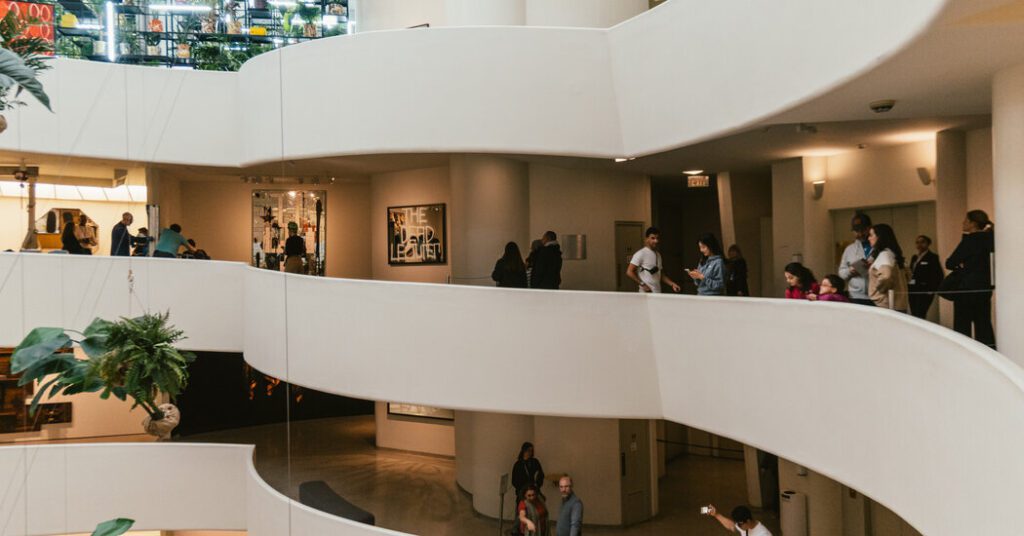The Influence of Mega-Galleries in New York’s Art Scene
Recent exhibitions at prominent New York institutions highlight the growing impact of mega-galleries in shaping the art landscape. Notable events include a champagne toast at the Whitney Museum for Amy Sherald—known for her portrait of Michelle Obama—and a retrospective celebrating Jack Whitten at the Museum of Modern Art. Additionally, Rashid Johnson’s extensive solo exhibition at the Solomon R. Guggenheim Museum has drawn significant attention. In contrast, next month’s exhibition by conceptual artist Lorna Simpson at the Metropolitan Museum of Art promises to further enrich the New York art scene.
Dominance of Hauser & Wirth
Central to this trend is Hauser & Wirth, a gallery known for its impressive roster of contemporary artists. This season, their artists dominate exhibitions across New York, prompting discussions of “Hauser spring.” A New York Times analysis indicates that among 350 contemporary solo exhibitions since 2019, nearly 25% were featured by just 11 major galleries, with Hauser & Wirth leading the pack with 18 exhibitions in six and a half years.
Commercial Interests and Museums
This prominence of mega-galleries has sparked debate regarding the relationship between commercial dealers and museums. As economic pressures mount due to reduced attendance and lower corporate sponsorships—accelerated by the pandemic—museums have begun relying on the financial and logistical support provided by these galleries. Some experts caution that such partnerships may lead to conflicts of interest, as exhibitions can elevate artists’ profiles and market prices, benefiting the galleries involved.
Changing Financial Dynamics
Traditionally, museums operated independently from commercial interests, but shifting financial landscapes have altered this dynamic. Many institutions now welcome partnerships with galleries for logistical and financial assistance, marking a significant change in the art world. For instance, while MoMA refrains from accepting gallery funding, organizations like the Whitney and the Met do not, often citing the usefulness of gallery support in securing artwork loans and installation resources.
Hauser & Wirth: Strategy and Success
Since its establishment in the U.S. in 2009, Hauser & Wirth has grown into a global powerhouse with multiple locations, including three in Manhattan. Their strategy includes not only funding exhibitions but also hiring museum curators and facilitating artwork loans from private collectors. These efforts have increased visibility for their artists, with statements from Marc Payot, the gallery’s president, emphasizing the importance of institutional presence for artist longevity.
Policies and Museum Collaborations
Exhibition funding policies vary among museums. The Met and Whitney have embraced financial support from galleries, while MoMA has maintained a stricter policy against such funding. The decisions about exhibitions are reportedly made based on artistic merit rather than financial considerations. Ann Bailis from the Met has acknowledged that galleries can assist in securing loans, underscoring the collaborative spirit between these institutions.
The Landscape of Contemporary Art
Currently, a significant percentage of solo exhibitions in New York museums skew towards artists represented by mega-galleries. Studies show that over half of the solo shows at the Morgan Library & Museum and nearly 40% at the Guggenheim featured such artists. In contrast, smaller institutions focus more on underrepresented artists, showing less reliance on mega-gallery support.
Looking Ahead
Despite concerns around the influence of mega-galleries, initiatives are still in place to highlight diverse, lesser-known artists. A considerable 20% of solo exhibitions at top museums since 2019 have showcased artists without gallery representation. This indicates a continuing effort by curators to promote a broader range of talents, even amid fiscal pressures and evolving gallery-museum dynamics.
In summary, as Hauser & Wirth and similar galleries continue to define the contemporary art scene, the relationship between commercial and non-profit art institutions will likely evolve further. Upcoming exhibitions from new talents exemplify the ongoing dynamism and challenges present in today’s art world.


